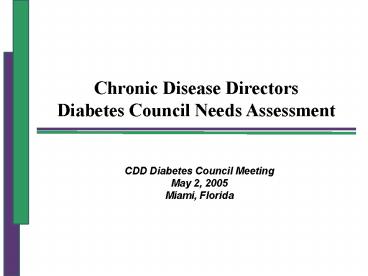Chronic Disease Directors Diabetes Council Needs Assessment - PowerPoint PPT Presentation
1 / 21
Title:
Chronic Disease Directors Diabetes Council Needs Assessment
Description:
Miami, Florida. Partnership History ... Broadcast News. Medium. Channel. HISPANIC AND LATINO AMERICANS. COMMUNITY PARTNERS. BUSINESSES ... – PowerPoint PPT presentation
Number of Views:23
Avg rating:3.0/5.0
Title: Chronic Disease Directors Diabetes Council Needs Assessment
1
Chronic Disease Directors Diabetes Council Needs
Assessment
CDD Diabetes Council Meeting May 2, 2005 Miami,
Florida
2
Partnership History
- Purpose Identify any gaps, barriers or areas of
opportunity for programs, resources or
partnerships, as well as best practices and
promising strategies that can be used as examples
for other programs.
3
Methodology
Created Advisory Board
Conducted In-Depth Interviews
Pilot Tested the Assessment
Assessment to Field
4
Participant Overview
70 of Programs Completed the Assessment
31 Midwest Region
25 Northeast Region
31 West Region
19 Southeast Region
5
Program Snapshot
What are the main projects, campaigns, or
activities in place to reach your objectives?
28
Capacity Building
Awareness
21
Professional Education
12
11
Self-Management
10
Clinical Care
Quality Improvement
7
6
Drivers
What are the facilitators or mandates for your
Programs priorities and/or objectives?
Performance Improvement Plan
100
CDC National Objectives
94
Strategic Plan
78
Healthy People 2010
78
State Goals
56
7
Access to Materials
Do you feel you have access to materials/tools
that meet the needs of your target audiences?
53
Yes
47
No
If not, what are some of your specific needs?
Ranked in Order of Importance
1. Culturally Appropriate Materials
2. Literacy Level Materials
3. Language Appropriate Materials
4. Training Materials
8
Further Tailored Materials
Which groups within your state/territory do you
feel may require further tailored communications?
Rural Populations
51
Hispanic and Latino Americans
43
Community Partners
43
Businesses
37
9
Channel and Medium
Which channel and medium do you feel are most
effective for each audience?
Medium
Channel
RURAL POPULATIONS
Community Groups
Broadcast News
HISPANIC AND LATINO AMERICANS
Community Groups
1-to-1 from HCP
COMMUNITY PARTNERS
Presentations
Presentations
BUSINESSES
10
Partnerships
Who are your Programs key partners?
Other Government Agencies
100
Academic Institutions
97
89
Community-based
Patient Advocacy Groups
86
83
Faith-based
Businesses
74
11
Partnerships
On what types of activities do you work with
partners?
Public Awareness
94
Public Education
94
84
Patient Education
Promulgation of Standards of Care
84
81
QI Projects
Policy Development
72
Development of Standards of Care
69
12
Partnerships
What kinds of new partnerships would you like to
see?
Businesses
80
Schools
57
54
Insurance Carriers
51
Provider Networks
Faith-based
43
Professional Groups
43
Social Organizations
26
13
Partnerships
What, if any, are the challenges to partnerships?
Time
92
86
Staffing
58
Turf
Trust
50
14
Best Practice Sharing
With which programs are you currently sharing
information/best practices?
Other Agencies
89
Community Partners
89
86
PCPs
Diabetes Education Programs
72
Medicaid/Medicare
67
Other DPCPs
64
School-based Programs
53
15
Best Practice Sharing
What types of opportunities to share information
and best practices would you like to see?
72
Regional Meetings
64
Teleconferences
61
Web Sites
Best Practices Award Program
47
44
Web Boards
16
Best Practice Sharing
What are the challenges to creating these types
of best practice sharing programs?
97
Staff Time
49
Skill Development
Travel
46
Staff Retention
31
Lack appropriate technology
31
Adequate staff training/orientation
31
17
Self-Identified Areas
Which areas of your Program are in the most need
of additional resources?
77
Evaluation
56
HCP Programs
Awareness Campaigns
47
Communication Dissemination
47
Partnership Development
44
18
Self-Identified Areas
- What, if any, do you feel are immediate
opportunities for your Program? - Collaborations (ex., schools, non-professional
partners, medical school) - New and Expanded Programs (ex., advocacy, health
literacy, web based, satellite) - Training (ex., new staff, school nurses)
- Capacity Building (ex. new staff, legislative
advocacy)
19
Self-Identified Areas
- What types of information/resources would help
you improve your Program? - Materials advocacy, cultural/linguistic,
training, billing and reimbursement, support
group, low literacy, assessment and evaluation,
professional education - Media DVDs, CDs, Videos, written
- Audiences General practitioners, nurses, high
risk populations, patient advocates
20
Self-Identified Areas
What are the top 3 items on your wish list?
Access to Decision Makers
Evaluation Tools/Resources
Less Paperwork
Less State Bureaucracy
Increased Cooperation among All Key Stakeholders
Initiatives/Tools to Address Health Disparities
Adequate Reimbursement for Prevention and
Education Services
Better Cooperation among Staff
Staff Time
Funding
21
Key Points
A. Partnerships
- Businesses, Insurance Carriers
B. Best Practices/Sharing
- Especially Between DPCPs
- Regional Meetings, Award Programs
C. Further Tailored Materials
- Rural Populations, Hispanic/Latinos
D. Evaluation
- Resources, Tools, Process































